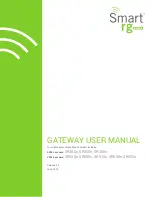
L-Band IF Application Guide
Page L-Band - 7
Caution: If the receive frequency stability exceeds the channel spacing then there
is the possibility of locking to adjacent similar carriers!
•
LNB output Connector: 75 Ohm type “F” connector, while a Type “N” connector would be
preferable for reliable weather proofing. If type F is used insure that it is weather sealed.
3.3
Outdoor Equipment Power Provision
Block UpConverter Power. Current BUCs may require anywhere from approximately 12 VDC to –
48 VDC depending on the manufacturer. Approximately 50 Watts is not uncommon. The power is
typically applied via the transmit cable, and removed by the BUC for internal use. The PSM-
4900L contains an internal transmit Bias T/Mux to apply the power and reference signals to the
transmit line. See figure x for an example of this configuration
LNB Power. Most current data grade LNBs require approximately 15 to 24 VDC at 200 to 300
milli-Amps. The power is typically applied via the receive cable, and removed by the LNB for
internal use. The PSM-4900L contains an internal receive Bias T/Mux to apply the power and
reference signals to the receive line.
3.4 Station
Reference
Most current BUCs require an external 10 MHz reference supplied on the cable which they
demultiplex and use to phase lock the Upconverter Local Oscillator. The two characteristics
required here are very good stability (an OCXO) and low phase noise. The BUC manufacturer
should specify the requirements, but it is not difficult to figure out some minimum capabilities.
First, to achieve an Intelsat specified transmit signal uncertainty of 50 Hz per 1 kbps. A C-Band
reference for a 32 kbps carrier would require approximately 2 parts in 10
7
stability minimum. This
is +/- 1200 Hz at 6 GHz transmit frequency. A Ku-Band BUC would require 1 part in 10
7
stability
for a 32 kbps data rate. Higher data rates would require less stability.
The typical BUC level requirement for the reference input is usually somewhere b5 and
–3 or –5 dBm from a sine wave oscillator. The PSM-4900 output is nom3 dBm allowing for
significant cable loss at 10 MHz.
The reference oscillator phase noise is multiplied when phase locking the BUC Local Oscillator.
Thus the phase noise on the oscillator must be extremely low and probably cannot be viewed
directly on a spectrum analyzer. Its effect however will be visible on the BUC output with a known
clean carrier input.
3.5
Safety and Lightning Protection
The block diagram shown above does not incude any provisions for lightning arrestors or
protections devices. The typical “spark gap” type of receive line device, providing a connection for
a line to the station earth ground is probably suitable for the receive side. Similar devices used on
the transmit side must be able to handle up to approximately 5 or 6 Amps to allow for the BUC
current. Many common devices are termed “quarter wave” arrestors and should NOT be used.
These are narrow band devices which contain a direct short to ground. Gas discharge type
arrestors are probably suitable. Local electrical codes should be checked to insure compliance.
It is very important to securely ground the antenna structure directly to a good low impedance
earth ground connection.
3.5.1 BUC Power Safety
With the inclusion of the BUC power supply on the transmit IF cable comes several safety
concerns:
•
First, the BUC power should not be enabled via the modem until the cabling is
completely installed. Danger to both personnel and equipment is possible when
































